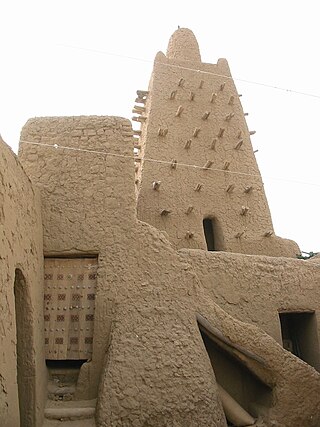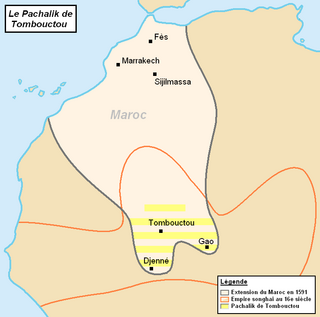Related Research Articles

The Mali Empire was an empire in West Africa from c. 1226 to 1670. The empire was founded by Sundiata Keita and became renowned for the wealth of its rulers, especially Mansa Musa. At its peak, Mali was the largest empire in West Africa, widely influencing the culture of the region through the spread of its language, laws, and customs.

Timbuktu is an ancient city in Mali, situated 20 kilometres north of the Niger River. It is the capital of the Tombouctou Region, one of the eight administrative regions of Mali, having a population of 54,453 in the 2009 census.

The Songhai Empire was a state located in the western part of the Sahel during the 15th and 16th centuries. At its peak, it was one of the largest African empires in history. The state is known by its historiographical name, derived from its largest ethnic group and ruling elite, the Songhai people. Sonni Ali established Gao as the empire's capital, although a Songhai state had existed in and around Gao since the 11th century. Other important cities in the kingdom were Timbuktu and Djenné, where urban-centred trade flourished; they were conquered in 1468 and 1475, respectively. Initially, the Songhai Empire was ruled by the Sonni dynasty, but it was later replaced by the Askia dynasty (1493–1591).

The Songhai people are an ethnolinguistic group in West Africa who speak the various Songhai languages. Their history and lingua franca is linked to the Songhai Empire which dominated the western Sahel in the 15th and 16th century. Predominantly adherents of Islam, the Songhai are primarily located in Niger and Mali within the Western Sudanic region. Historically, the term "Songhai" did not denote an ethnic or linguistic identity but referred to the ruling caste of the Songhay Empire known as the Songhaiborai. However, the correct term used to refer to this group of people collectively by the natives is "Ayneha". Although some Speakers in Mali have also adopted the name Songhay as an ethnic designation, other Songhay-speaking groups identify themselves by other ethnic terms such as Zarma or Isawaghen. The dialect of Koyraboro Senni spoken in Gao is unintelligible to speakers of the Zarma dialect of Niger, according to at least one report. The Songhay languages are commonly taken to be Nilo-Saharan but this classification remains controversial: Dimmendaal (2008) believes that for now it is best considered an independent language family.
Aḥmad Bābā al-Timbuktī, full name Abū al-Abbās Aḥmad ibn Aḥmad ibn Aḥmad ibn Umar ibn Muhammad Aqit al-Takrūrī Al-Massufi al-Timbuktī, was a Sanhaja Berber writer, scholar, and political provocateur in the area then known as the Western Sudan. He was a prolific author and wrote more than 40 books.

Askia Muhammad I (1443–1538), born Muhammad ibn Abi Bakr al-Turi or Muhammad Ture, was the first ruler of the Askia dynasty of the Songhai Empire, reigning from 1493 to 1528. He is also known as Askia the Great, and his name in modern Songhai is Mamar Kassey. Askia Muhammad strengthened his empire and made it the largest empire in West Africa's history. At its peak under his reign, the Songhai Empire encompassed the Hausa states as far as Kano and much of the territory that had belonged to the Songhai empire in the east. His policies resulted in a rapid expansion of trade with Europe and Asia, the creation of many schools, and the establishment of Islam as an integral part of the empire.

Sankoré Madrasa is one of three medieval mosques and centres of learning located in Timbuktu, Mali, the others being the Djinguereber and Sidi Yahya mosques. Founded in the 14th century, the Sankoré mosque went through multiple periods of patronage and renovation under both the Mali Empire and the Songhai Empire until its decline following the Battle of Tondibi in 1591. The mosque developed into a madrasa, reaching its peak in the 16th century. The term "University of Sankoré" has sometimes been applied to the Sankoré madrasa, though there is no evidence of a centralized teaching institution such as the term university implies. Instead the mosque served as the focal point for individual scholars with their own private students, and as a location in which some lectures and classes were held.
Askia Mohammad Benkan, also Askiya Muhammad Bonkana Kirya, was the third ruler of the Songhai Empire from 1531 to 1537.

The Djinguereber Mosque, also known as Djingareyber or Djingarey Ber, is a famous learning center in Timbuktu, Mali. Built in 1327, it is one of three madrassas composing the University of Timbuktu. It was inscribed on the list of UNESCO World Heritage Sites in 1988.

The Sidi Yahya Mosque, also known as the Mosque of Muhammad-n-Allah, is a mosque and madrasa of Timbuktu in Mali. The construction of the mosque began in 1400 under the leadership of Sheikh el-Mokhtar Hamalla of Timbuktu and was finished in 1440.

Articles related to Mali include:
Askia Musa or Askiya Musa was the second Askia ruler of the Songhai Empire.
Qadial-Aqib ibn Mahmud ibn Umar ibn Muhammad Aqit was a Sanhaja Berber qadi of Timbuktu and Imam of Sankore mosque.
The University of Timbuktu is a collective term for the teaching associated with three mosques in the city of Timbuktu in what is now Mali: the mosques of Sankore, Djinguereber, and Sidi Yahya. It was an organized scholastic community that endured for many centuries during the medieval period. The university contributed to the modern understanding of Islamic and academic studies in West Africa during the medieval period and produced a number of scholars and manuscripts taught under the Maliki school of thought.
Askia Ishaq I, also known as Ishaq Ber or Ishaq Kadibini, was the ruler of the Songhai Empire from 1539 to 1549, elected Askia following the death of Askia Isma'il. He was the fifth ruler of the Askiya dynasty.

The Pashalik of Timbuktu, also known as the Pashalik of Sudan, was a West African political entity that existed between the 16th and the 19th century. It was formed after the Battle of Tondibi, when a military expedition sent by Saadian sultan Ahmad al-Mansur of Morocco defeated the Songhai Empire and established control over a territory centered on Timbuktu. Following the decline of the Saadi Sultanate in the early 17th century, Morocco retained only nominal control of the Pashalik.
Askia Daoud was the ruler of the Songhai Empire from 1549 to 1582. His rule saw the empire rise to a peak of peace and prosperity following a series of succession disputes and short reigns.
The Moroccan invasion of the Songhai Empire began with an expedition sent in 1590 by Sultan Ahmad al-Mansur of the Saadian dynasty, which ruled over Morocco at the time. The Saadian army, led by Judar Pasha, arrived in the Niger valley region in 1591 and won its first and most decisive victory against the forces of Askia Ishaq II at the Battle of Tondibi and occupied the capital of Gao shortly after.
Askia Muhammad Gao was the last ruler of the Songhai Empire. A son of Askia Daoud, he assumed power in the last months of 1591 after the defeat of Askia Ishaq II by Moroccan forces at the Battle of Tondibi. About forty days after taking power he was lured into a trap and killed by the Moroccans.
References
- ↑ Gomez 2018, p. 296.
- ↑ Gomez 2018, p. 351.
- ↑ Gomez 2018, p. 285.
- ↑ Gomez 2018, p. 283.
- ↑ Gomez 2018, p. 362.
- ↑ "History of Timbuktu, Mali". Archived from the original on July 4, 2007. Retrieved 2007-07-17.
- bin Yahya al-Wangari, Mukhtar. "Shaykh Baghayogho al-Wangari and the Wangari Library in Timbuktu." in Jeppie, Shamil, and Souleymane Bachir Diagne (eds.)The meanings of Timbuktu. University of Cape Town Press, 2010. pp.277-285 https://publication.codesria.org/index.php/pub/catalog/download/141/1238/4156?inline=1
- Adama, Hamadou. "Ahmed Bâba at-Timbuktî." In Oxford Research Encyclopedia of African History. 2021.
- Gomez, Michael (2018). African dominion : a new history of empire in early and medieval West Africa. Princeton, NJ: Princeton University Press. ISBN 9780691177427.
- Hunwick, John. "Timbuktu: A Refuge of Scholarly and Righteous Folk." Sudanic Africa14 (2003): 13-20.
- Hunwick, John. "Towards a History of the Islamic Intellectual Tradition in West Africa down to the Nineteenth Century." Journal for Islamic Studies 17 (1997): 4.
- Singleton, Brent D. "African bibliophiles: Books and libraries in medieval Timbuktu." Libraries & Culture 39, no. 1 (2004): 1-12.
- W. Massing, Andreas. "Baghayogho: A soninke Muslim diaspora in the mande world." Cahiers d’études africaines 176, no. 4 (2004): 887-922.